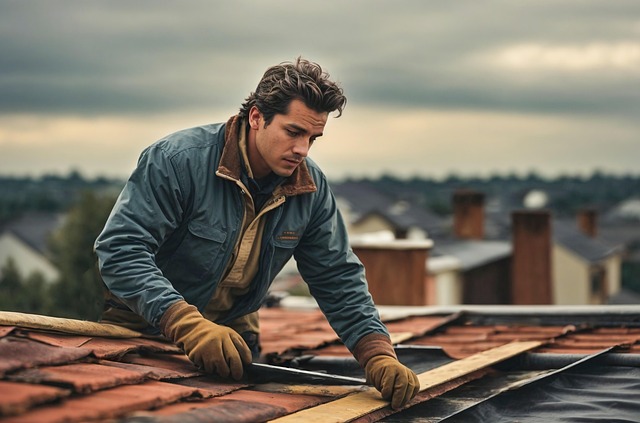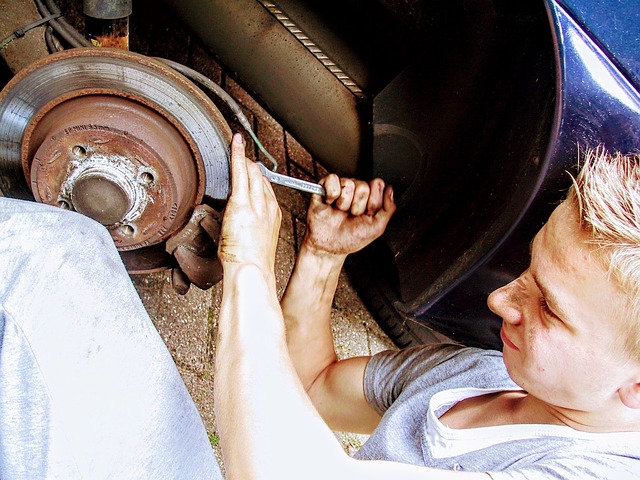Shingle roofs, common yet complex, demand meticulous care for optimal protection and aesthetics. Damage from winds, debris, UV rays, and age impacts durability and requires professional shingle roof repair. Assessment is key, identifying missing or damaged shingles, granule loss, and moisture intrusion. Experts use advanced tools and techniques, from adhesives to full replacement, ensuring water-tight security. High-quality industry-standard shingles extend lifespan with impact resistance and warranties. DIY minor repairs, but complex issues demand professional attention for steep slopes or decay. Regular maintenance, including inspections and gutter cleaning, prolongs roof life, averting costly repairs.
“Uncover expert shingle roof repair techniques and ensure your home’s safeguard against the elements. This comprehensive guide delves into the intricacies of shingle roofs, exploring materials, types, and common issues like missing or damaged shingles, leaks, and wear from harsh weather. Learn essential assessment steps before repairing, along with tools and techniques for lasting solutions. Discover how to choose the right shingles and maintain your roof for optimal lifespan, leaving you with a secure and vibrant dwelling.”
Understanding Shingle Roofs: Materials and Types

Shingle roofs are a common sight across many homes, offering both aesthetic appeal and robust protection against the elements. Understanding this roofing system involves grasping the diverse materials and types available in the market today. Asphalt shingles, the most prevalent choice for residential properties, are known for their affordability and ease of installation. These shingles are made from a blend of asphalt and synthetic fibers, coated with a protective layer to withstand weathering.
Beyond asphalt, other options include wood shakes, slate, and metal shingles. Each material offers unique characteristics in terms of durability, appearance, and maintenance requirements. For instance, wooden shakes provide a natural, rustic look but demand regular upkeep to prevent rot and insect damage. Slate shingles are renowned for their exceptional longevity and distinctive aesthetic, though they can be more costly. Metal alternatives, such as aluminum or copper, offer excellent resistance to fire and extreme weather conditions, making them a popular choice for those seeking long-lasting protection, especially in areas prone to harsh climates.
Common Shingle Roof Repair Issues and Their Causes

Shingle roofs, while durable, are susceptible to a variety of issues that can compromise their integrity and appearance. Common problems include missing or damaged shingles, which often result from high winds, falling debris, or age-related degradation. These events can leave exposed underlayment and even structural damage if left unattended.
Another frequent issue is granule loss, where the protective granules on shingles wear off over time due to exposure to UV rays, extreme temperatures, or regular foot traffic. This not only reduces the shingle’s lifespan but also accelerates the aging process of the entire roof. Moisture intrusion is yet another concern, caused by poor flashing, missing gutters, or gaps around vents and chimneys. Such issues can lead to water damage, mold growth, and even structural decay if not promptly addressed through expert shingle roof repair.
Assessing Damage: Steps Before Repair

Before embarking on any shingle roof repair, it’s crucial to assess the damage thoroughly. Start by inspecting your roof for loose or missing shingles—a common sign of wear and tear due to extreme weather conditions. Walk around your property and look for any visible cracks or holes in the shingles, as these could indicate structural issues.
Up close, examine the granules on your shingles for signs of loss or deterioration. If you notice a significant amount of missing granules, it might signal the need for a complete roof replacement rather than just repairs. Take note of any flashing damage around chimneys or vents, as these areas are particularly vulnerable to leaks. Documenting these findings will help guide the scope of work for your professional shingle roof repair service.
Tools and Techniques for Expert Shingle Repairs

When it comes to expert shingle roof repair, a well-stocked tool belt is essential. Traditional tools like hammer, nails, and a ladder are foundational, but specialists often employ more advanced equipment such as power saws for quick and precise cuts, especially during tear-off or replacement phases. Tools like pry bars facilitate safe removal of damaged shingles without causing further injury to the roof structure.
Techniques vary based on shingle type and extent of damage. For minor repairs, a skilled roofer might use specialized adhesive to reattach loose shingles. More significant issues may require replacing entire sections of roofing. This involves meticulous work—removing old underlayment, installing new, and securing replacement shingles with precision to ensure water tightness and longevity.
Long-Lasting Solutions: Choosing the Right Shingles

When it comes to shingle roof repair, selecting the right shingles is a crucial step in ensuring long-lasting solutions. High-quality shingles offer superior durability and protection against the elements, making them a wise investment for any homeowner. Look for brands known for their robust materials and advanced manufacturing techniques, which can withstand harsh weather conditions and resist degradation over time.
The longevity of your roof repair depends on choosing shingles that match or exceed industry standards. Consider factors like impact resistance, fire rating, and warranty coverage when making your selection. By opting for top-tier shingles, you not only enhance the aesthetic appeal of your property but also safeguard against costly repairs in the future, ensuring a secure and durable roof over your head.
Step-by-Step Guide to Shingle Roof Repair

Shingle roof repair is a process that requires careful attention and specific steps to ensure longevity and optimal protection for your home. Here’s a step-by-step guide to help you navigate this task:
1. Assess the Damage: Start by inspecting your roof thoroughly. Look for missing, damaged, or curled shingles. Identify areas with leaks or signs of moisture intrusion. This initial assessment will guide your repair process and help you prioritize the necessary fixes.
2. Gather Materials: Collect all the required materials before beginning the repair. You’ll need new shingles (matching the existing type and color), roofing cement or sealant, a brush for applying sealant, a hammer, nails suitable for roof work, and safety gear, including gloves and a hard hat. Ensure you have enough supplies to complete the job without interruptions.
3. Remove Damaged Shingles: Carefully take out the damaged or missing shingles using a utility knife or roofing sword. Be cautious when handling these materials as they can be sharp. Once removed, clean the roof deck, ensuring no debris or dirt remains, as this could affect the adhesion of new shingles.
4. Install Underlayment (if needed): If your existing underlayment is damaged or old, replace it. The underlayment provides an extra layer of protection and prevents moisture from seeping through. Follow the manufacturer’s instructions for proper installation.
5. Apply Roofing Cement/Sealant: Use a brush to apply roofing cement or sealant along the edges and corners of the new shingles. This step ensures a strong bond between the shingles and the deck below.
6. Install New Shingles: Begin laying down new shingles, starting from the bottom edge of the roof. Overlap each shingle slightly with the one above it. Secure them in place using nails, ensuring they’re hammered in gently to avoid damage.
Professional vs DIY: When to Hire Experts

When it comes to shingle roof repair, deciding between professional services and DIY approaches is crucial. While some minor repairs can be tackled by homeowners with basic tools and knowledge, more complex issues often require expert attention. Shingle roof repair specialists possess the necessary skills, experience, and access to high-quality materials to ensure long-lasting solutions. They understand the intricate details of various roofing systems, from identifying problem areas to implementing effective fixes that protect your home from water damage, leaks, and structural weaknesses.
Hiring professionals is especially recommended for roof repairs following severe weather events or when dealing with damaged or missing shingles, flashing issues, or signs of decay. Experts can navigate the challenges posed by steep slopes, intricate designs, or hard-to-reach areas, ensuring safety and precision throughout the repair process. Their expertise also comes with warranties, offering peace of mind and financial protection against future issues.
Maintenance Tips for Optimal Shingle Roof Lifespan

Regular maintenance is key to extending the lifespan of your shingle roof and avoiding costly repairs. Here are some essential tips to keep your roof in top condition:
Start by inspecting your roof at least twice a year, especially after severe weather events like storms or heavy snowfall. Look for any missing or damaged shingles, as these can compromise the entire structure. Keep an eye out for signs of moisture or water damage, as they could indicate leaks and further complications. Cleaning your gutters regularly is also vital; blocked gutters can lead to water pooling around the roof, causing potential issues over time. Additionally, ensuring proper ventilation helps regulate the roof’s temperature, preventing excessive wear and tear on the shingles.
